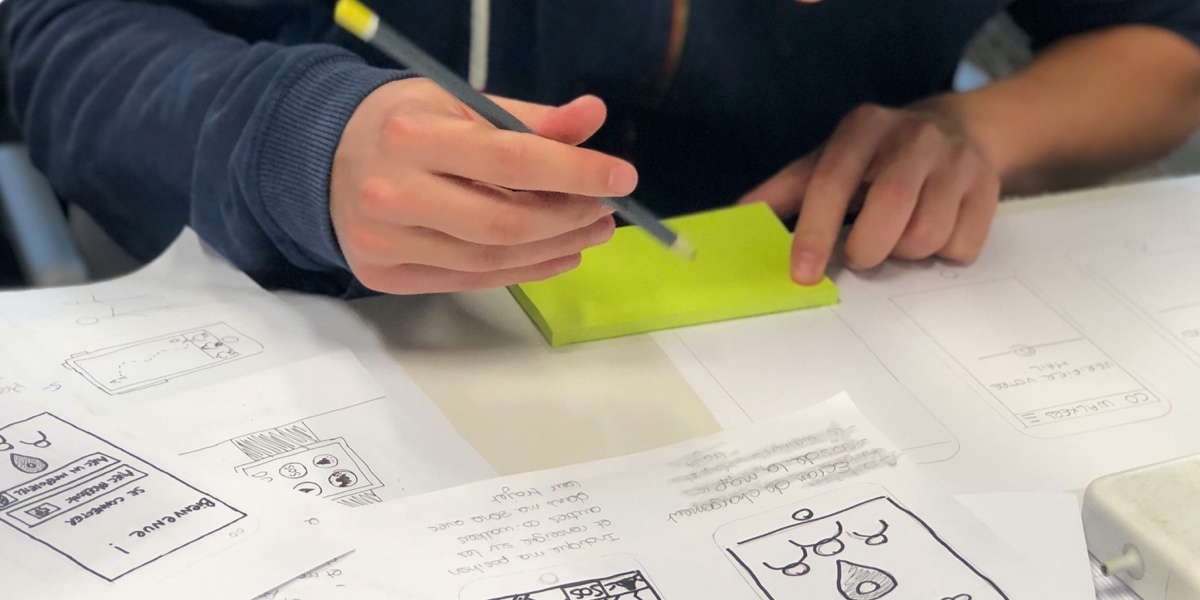So UX writing has captured your curiosity—maybe you’re thinking about pursuing it as either an enhancement to your current work or an entirely new direction for your career.
Now the question is what to do next.
And when you consider all the options for UX writing courses and UX writing books (and so much more) available to you—along with a schedule that’s likely already quite full of work, family, friends, hobbies, and the rest of your life—the answer isn’t exactly simple.
I’ve been there. I started learning about UX writing while I was working two jobs, relocating to a new country, and then starting a brand new job. So I wanted to share some of my experience (including a candid review of the UX writing course at UX Writing Hub) to hopefully give you a little clarity on what your next steps could be. I’ll touch very briefly on what UX writing is in the first place (just in case you’re early in your exploration), why I was interested in it, how I started learning it, and my experience with the UX Writing Academy at UX Writing Hub.
- What is UX writing, anyway?
- Why UX writing, and how I started learning it
- My experience with the UX Writing Academy at UX Writing Hub
- What next?

Photo by Nick Morrison on Unsplash
1. What is UX writing, anyway?
UX writing is the practice of creating copy that is specifically and intentionally designed to meet users’ needs, build rapport, and guide them effectively through an experience (usually with a digital product). This often takes the form of microcopy, but could also involve writing product pages, emails, or any other kind of user-facing copy.
To accomplish this goal, UX writers follow a in iterative process that looks a lot like the design thinking process:
- UX writers start by empathizing with their users—getting in touch with users’ need and goals (and the language they use) through user research methods such as interviews, surveys, and conversation mining
- Next, they define the problems they need to solve with their copy, and where those problems exist in the user flow
- Once they’ve got a clear idea of the problem to be solved, UX writers ideate and come up with solutions in the form of copy (sometimes several options, and often housed in a copydoc).
- This ideation often happens immediately before (or simultaneous to) the creation of a prototype, which allows the UX writer to put their copy solutions in the context of the user experience (to see what it will actually look like for users).
- Finally, they test the copy to ensure that it actually works for users the way it should
Read more about what UX writing is and why it matters in this article—and about what UX writers actually do, in this one.
2. Why UX writing, and how I started learning it
Back in 2017, I was teaching writing, research, and ESL (English as a second language) full-time at a university, and writing/editing on a freelance basis. I enjoyed teaching and saw first-hand how the way we communicate with students impacts their ability to learn and apply their new knowledge in real ways.
At the time, I was also maintaining relationships with friends and family, volunteering for two organizations, trying to figure out how to move to Germany (a long-time personal goal). More than anything, I wanted to find a way to integrate my love for connecting with people (users, students, whatever you need to call them in any given context) with my love for writing—in a way that was outside of academia and allowed me more time to create.
Somewhere along the way, I discovered this article about UX writing by Amanda Mohlenhoff (as of this writing, she is the Senior UX Manager at GetYourGuide). This was the first I’d heard of UX writing and I was wildly intrigued. I had that “this is it” feeling. I started digging around and quickly realized that I already had the writing chops for this, but I needed a foundation in this whole “UX” thing—whatever that was. So I found a UX design school, completed a certification, and read a bunch of UX writing books along the way. But it wasn’t enough! I needed some hands-on practice. So I completed a 15-day UX writing challenge, which was awesome and just enough to make me absolutely certain I was headed in the right direction.
While all of that was going down, I relocated to Berlin, and landed a job (my current role!) that was the perfect mix of familiar writing territory (blog writing), and new horizons—writing copy for the company website, emails, and more. Luckily, this job was at a company with an impressive commitment to continuous learning and professional development. They covered the cost of the course and helped me find the time to complete it. I enrolled in the UX Writing Academy at UX Writing Hub and…that’s what the rest of this article is about!

(Image credit: UX Writing Hub)
3. My experience with the UX Writing Academy at UX Writing Hub
So, I’m going to walk you through my experience with UX Writing Hub’s UX Writing Academy based on five elements (or criteria) that were most significant to me—and that I think are core elements to any high quality certification program:
- Course structure and content
- Duration and pacing
- Peer interaction and collaboration
- Mentor support
- Practical application of knowledge
But first, a brief overview.
Overview
Spoiler alert: With a few hiccups on the clarity/communication side of things (nothing major, but more on that in a moment), this course was everything I’d hoped it would be. I received:
- Structured learning
- Hands-on practice
- Individualized feedback from my mentors
- Opportunities to collaborate with my fellow students
- The chance to do some actual—as opposed to hypothetical or “just for practice”—UX writing for a really amazing product (more on that in a moment)
I should note that this course is relatively intensive if you really get into it. It takes 5-6 months to complete at about 10-15 hours per week—which can be a lot (or too much), depending on the other commitments you’re working around. The up-side to this: It offers a quality, hands-on, immersive learning experience.
It also isn’t the cheapest UX writing course on the market—nor should it be for the value it offers. Depending on the payment option, the total enrollment cost comes in between $2500-2750—but there are no hidden costs as the tools used throughout the course are all free (or free versions). I was fortunate enough to have an employer who offers time and budget for professional development, and I am aware that this isn’t a privilege that everyone has. But if you’re able to afford it, the value of this course is very much worth it.
Course structure and content
The UX Writing Academy is structured into eight modules that cover everything from the very basics of UX writing and research to competitor analysis, content style guides, copy testing, and content strategy. Impressive scope!
The format is largely written with practical exercises positioned throughout, so you’ll read lessons, do exercises, and check sections off as you go. The content also includes several videos and excellent supplemental resources for further reading and exploration. Then there are weekly group video calls to facilitate discussion, resolve any questions, and keep the group moving forward through the curriculum.
UX Writing Hub regularly hosts a pretty impressive lineup of online events with influential voices in the field, and their students get free access to these events—which serves as a kind of “guest lecturer” element in the course, exposing students to UX writers and content strategists who are making an impact in the industry (other than their course mentors, which I’ll share more about in just a minute).
Before you reach the (optional) practicum at the end, most of the exercises contribute directly to the completion of a project that can be used in your professional UX writing portfolio. This project centers around a hypothetical product that, module by module, students take from start (initial ideation and research) to finish (prototyping and testing).
In my case, I created a product intended to help writers hone their craft. I did research with writers in my network, created a style guide, came up with user flows and journey maps, then wrote the copy, prototyped, and tested it. Hypothetical product or not, the experience was very real, hands-on, and intensive. Quite the journey!

Photo by Amélie Mourichon on Unsplash
Duration and pacing
I’ll give you the short story first: The course took more time to complete than I expected, but only because I ended up spending 15-20 hours per week on the coursework (rather than their recommended 10-15). But that’s 100% because I tend to work in a very thorough manner and am slowly unlearning my perfectionism (insert sweating emoji). In other words: I spent more time on the course per week than was required. But I also ended the course with some valuable learnings (more on this when I talk about mentorship).
The overall pace of the course was fairly clear from the start (due dates for various exercises throughout the modules) and they keep everyone on pace together by opening modules progressively as the group moves forward in the course. Some of that clarity faded as the course went on—and I think that’s the only snag I encountered: the occasional lack of clarity on what was due and when. But this seemed to be a result of due dates being shifted to accommodate the needs of the students, which was something I definitely appreciated.
The mentors were very good at staying in touch with students’ needs and were happy to adjust due dates when we needed some breathing room—but they still managed to keep us on track! This meant that I could keep up with my full-time job, and the rest of my life, without feeling like I was falling behind or failing.
Peer interaction and collaboration
Even though the course is 100% online, it didn’t feel like a 100% independent study or guided reading course—which I really appreciated. Rather than just reading or watching videos, I had daily interactions with my fellow learners. Even better, this high level of interaction was encouraged, but not required to complete the course, which meant that we were all engaging because we were curious to learn and ready to collaborate.
Exercises built into the course early on built a strong foundation and sense of community that I appreciated, and that continued until the end of the course (and after!). I don’t feel like I just “completed” the course; I feel like I was part of a community of writers working toward a common goal.
We had a weekly group video call with the mentors to discuss the course content, ask questions, and dig deeper into what we’d learned through the module learning materials. While it was of course encouraged to be there for all the calls, I was able to take one or two off when there were conflicts with my work schedule or when I was sick—again, without feeling like I was falling behind or no longer “part of the team.”
We were also able to see other students’ work periodically, which was helpful both in building on that “we’re in this together” feeling and as an opportunity to give/receive feedback.
And of course, I loved working together with other students in the course to complete the optional practicum at the end—but more on this in a moment.

Photo by Mimi Thian on Unsplash
Mentor support
When I’m learning a new skillset and growing in some new direction in my career, I find it essential to have input from people who have experience in the field. Where many online courses offer occasional feedback or discussion forums (usually discussions with fellow students, with occasional input from an expert), The UX Writing Academy put me in regular contact with an expert in the field (shoutout to Aaron Raizen)—and one who cared about my success not only in the course but in my career going forward.
Aaron gave me regular, individualized feedback on my projects, so I felt confident in the quality of my work as I went from one exercise to the next—and for me, that wasn’t the smoothest process.
After I finished my user research assignments, I realized that the product I had in mind wasn’t actually meeting the needs of the people I was (hypothetically) hoping to reach. I talked to my mentor and ultimately decided to tweak the product and re-do some of the research to make sure I had a strong foundation moving forward.
Rather than this turning into a horribly stressful scramble to re-do the work and catch up with the rest of the class, Aaron worked with me to figure out how to juggle it and re-prioritize assignments. All a part of developing real skills for the kinds of situations that come up in the real world!
Practical application of knowledge
As I mentioned before, the course takes you through the research and initial development of a hypothetical product (of your own design) from a content-first approach. Most of the assignments were geared towards that overarching project; the ones that didn’t contribute directly were designed to give a better understanding of a concept before going into the next step forward in that project.
Once the majority of the coursework is finished, though, there’s an optional practicum that turned out to be a really amazing experience and opportunity. We were given a set of projects for several companies/products (real ones!) and asked what we were most interested in working on. A small group of students was assigned to each company/product to carry out 1-4 project briefs over about a month’s time. This means that we got to be a part of a team of UX writers doing actual user research and UX writing for a real product—making an actual difference in the world!
I can’t say emphatically enough what a rewarding experience this practicum was. Given my interest in inclusive design and inclusive language, I was thrilled to end up on the team that worked with Kindship—an amazing social media app and community for parents of children with disabilities. I worked together with my fellow UX writers to conduct research and craft copy both for the platform and for their community emails.
Something worth noting here is that the team was working across multiple time zones and still managed to get everything done at high quality and on time! So the practicum wasn’t just “real world” experience I could put in my portfolio—it was also an experience that allowed me to fine tune my skills in remote communication and collaboration. And I have that shared experience with other UX writers across the globe, giving me a network of amazingly creative and insightful professionals who I can and have stayed in touch with long after adding the certification to my LinkedIn profile!
Kindship was so great to work with that I volunteered with them for a short time after completing the course (and hope to get back to it when life calms down a bit).

Photo by Austin Distel on Unsplash
4. What next?
If you’ve got a knack for words and a desire to have a real impact, get a sample taste of the UX Writing academy for free. If you’ve already done some research and feel pretty sure this is the right direction for you, you can check out their UX Writing Essentials course. And if you’re ready to dive into the deep end of UX writing and content strategy, you’ve probably figured out by now I’m a huge fan of the full UX Writing Academy. All in all, it’s a fantastic course that will immerse you in the UX writing community and take you from newbie to expert—with experience in the field.
And, of course, if you want to read more about UX writing before you do anything else, check out the resources I’ve linked throughout this review—that’ll give you a great start! And if you’re serious about breaking into the field, check out this list of ways to up your UX writing game.
